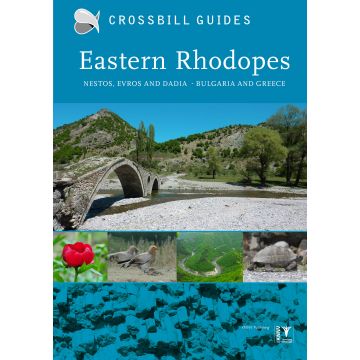Crossbill Guide Eastern Rhodopes - Greece and Bulgaria
Nestos, Evros and Dadia – Bulgaria and Greece

Tags
This guidebook describes the nature and wildlife of the Eastern Rhodope mountains around the Arda river and Madzharovo in Bulgaria, as well as Dadia forest, Evros and the Nestos river in Greece.
Landscape history
Ecosystems
Geology
Flora and Fauna
Where to watch birds
Finding orchids and other wildflowers
18 detailed routes with observation tips and 23 site descriptions
This guide has all you need to know about birdwatching, nature trails, hiking and geology. The book is your source for finding birds, including Masked Shrike, Sombre Tit, Levant Sparrowhawk and Black Vulture, but also describes where to find orchids, rare dragonflies, butterflies and reptiles. It contains both routes and interesting background information and is written for a wide audience of visitors.
In the border area of southeast Bulgaria and northeast Greece lie the remote mountains of the Eastern Rhodopes. This beautifully wild and unspoiled region is home to an extraordinary array of rare species and exciting habitats. Together with the adjacent National Park of Dadia, the Evros Delta and the Nestos Delta in Greece, this guide covers a whole range habitats, from salt and freshwater marshes to steep rock cliffs and from Mediterranean scrubland to cool beech forests.
Hidden trails: This is the heartland of ancient Thrace - a landscape of both rolling hills and steep and rocky crags. The mountains are sparsely populated and partially deserted, but have been recently discovered by nature travellers, both from Bulgaria and from abroad. They are (re)discovering the many hidden trails, the breathtaking landscapes and populations of flora and fauna, which include southern species such as Wolf, Golden Jackal, Masked Shrike, Western Rock Nuthatch, its many tortoises and snakes, the Bulgarian Emerald dragonfly and plenty of rare wildflowers. This region also ranks among the best in Europe to see birds of prey and reptiles. Of the first, the many Egyptian, Griffon and Black Vultures against the blue sky, are an iconic symbol of the Eastern Rhodopes. Looking on the ground, the frequent encounters with Greek and Hermann’s Tortoises crawling over the flower-speckled forest floor, form an unforgettable Rhodopean experience.
One of the most striking features of the region is the swift succession from mountains to coastal lowlands. The latter, with its pelicans, flamingos, ibises and Pygmy Cormorants is a treat on its own. The coast is mostly a birdwatching destination, with the Evros Delta, among the most important coastal wetlands of Europe, the pièce de resistance.
Blend of biogeographical regions: When exploring the area, expect the unexpected. The flora and fauna consists of a fascinating blend of both Mediterranean, temperate European and Pontic (eastern steppe) species, since the region lies right on the border of these three biological realms. As a result, typical Mediterranean habitat such as evergreen scrub, seamlessly merges with both steppe grasslands typical of the east, and deciduous forest from the north. And in this peculiar, blended landscape many species occur side by side that you would otherwise not expect. The habitats, varying from rocky, dry scrubland to lush, nearly subtropical riverine forests and steppes and from extensive arable land to dense forests, support a rich flora and fauna. This area boasts the highest raptor and reptile diversity in Europe.
The Crossbill Guide Eastern Rhodopes, including Nestos, Dadia and Evros (2013) is the first nature travel guidebook to cover this fascinating region. It will prove to be a compact and comprehensive aid to finding the most interesting, birds, plants, butterflies and dragonflies the region has to offer.
Gewicht:
450 g
Autor:
Alex Tabak, Alex Vliegenthart, Dirk Hilbers, Herman Dierickx
Verlag:
Reihe:
Medienart:
Bücher
Sprache:
Englisch
EAN:
9789491648014
Seiten:
256
Höhe in mm:
148
Breite in mm:
210
Erscheinungsjahr:
2013
Kontinent: Europa
Land: Griechenland, Bulgarien
Kategorien: Outdoor, Naturführer
Schreibe deine eigene Bewertung
Noch keine Herstellerangaben und Sicherheitshinweise verfügbar.